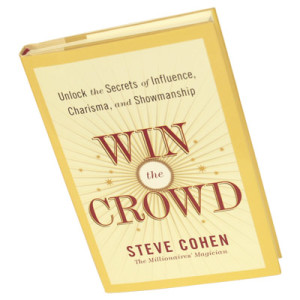 This article was originally published a few years ago at the RockStar Success Library. Still one of my favorite public speaking guides.
This article was originally published a few years ago at the RockStar Success Library. Still one of my favorite public speaking guides.
When you think about it, magicians are truly the masters of sales. We know that they are going to perform feats that are designed to fool us, we might even try to stay on our guard, but they always get us. And we love it – we even want more! For their illusions to work, magicians have to sell us over and over again.
In becoming a top magician, Steve Cohen has also become a master salesperson and communicator. In Win the Crowd, it’s fascinating to see how he’s drilled down into the ways he influences an audience, and how that can extrapolated into our daily conversations. Some of his techniques are quite sophisticated and require some time and practice, but that’s half the fun. It feels as if the curtains being drawn back a bit and Steve’s showing you how to make the magic work. Not necessarily tricks that require a white dove, but rather the dance that creates the communication and relationship between speaker and audience that good magic requires.
Big Thought
The same skills and tools that a master magician uses to captivate an audience can be used to improve everyone’s communication abilities – whether we’re presenting to a big group or speaking with someone one-on-one.
Implications, Ideas, and Questions
- The 5 Maxims of Magic (that can build your confidence in communication )
- Be Bold
- Expect Success
- Don’t State – Suggest
- Practice, Practice, Practice
- Be Prepared
- The idea of preparation stood out throughout the book. If you think about a magician’s show, everything is planned out and mastered ahead of time. Many, many hours of practice can go into an illusion that lasts just a few minutes. In the same way, I think that most of our important activities could benefit from more practice (an easy way to do this is to incorporate visualization – where you see your practice with your mind’s eye – into your routine).
- The focus on being a “showman” resonates with me because I spend a lot of time with clients talking about how other people perceive them and their businesses. That’s really all a “brand” is, how others perceive you. This is especially relevant because there’s an attitude of individuality in our culture that makes us want to ignore other people’s views of us, but communication rests not only on what we say, but on our audience’s perception.
- Steve’s chapter on “magic words” (chapter 10) was interesting and a lot of fun to read – especially because I’ve already integrated 6 of the 10 based on previous learning. One of my favorite new phrases is the layered command – especially important for leaders who want to create action and direct people (pg 137). It’s worth thinking about what you’re going to say before you say it.
- Steve points out that these skills shouldn’t be used to deceive someone, but rather make your communication more effective. Still, one of the questions that came up again and again in my mind as I was reading was “Where is the sweet spot between manipulation and influence?” In my opinion the differentiating factor is your intention – the purpose you are trying to achieve. As Steve explains, he can “manipulate” people’s perceptions in a magic show because they are expecting it – they want to be entertained. In everyday conversations, though, he wouldn’t use those same techniques on the unwary.
Should you read this book?
You shouldn’t read this book if you’re not ready to really amp up your communication tools (find out why this sentence works on page 147). In all seriousness, it’s a great book for really honing your skills – especially if your career involves selling or presenting. It’s not necessarily a beginner’s guide, but it’s filled with the tools that can bring a bit of “magic” to every conversation you have.
